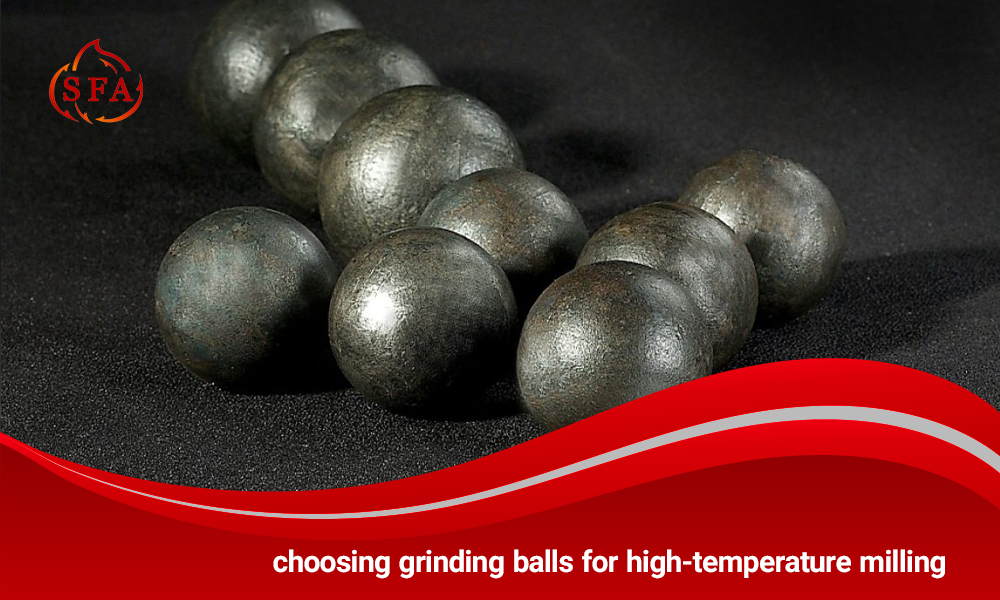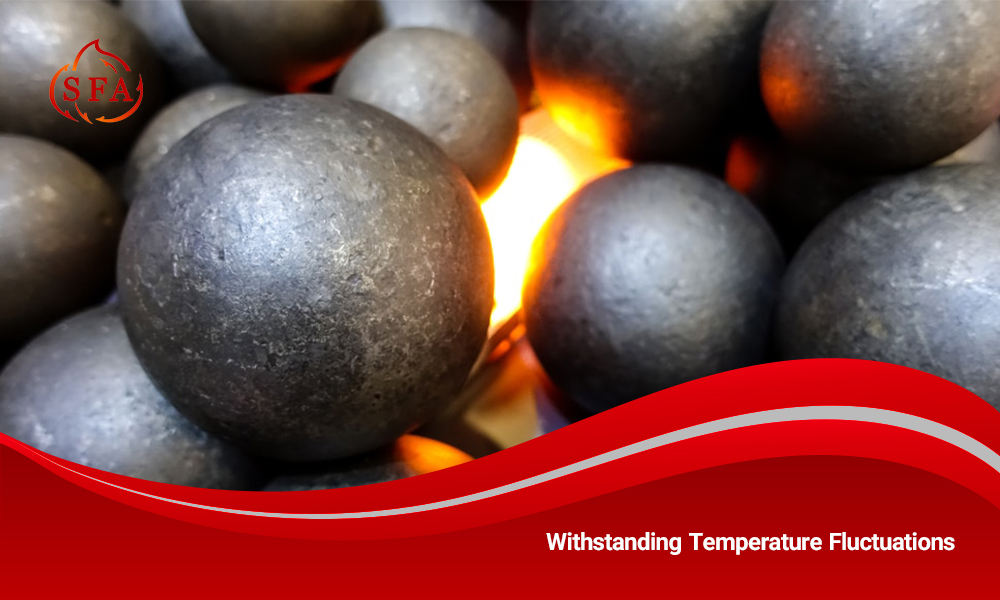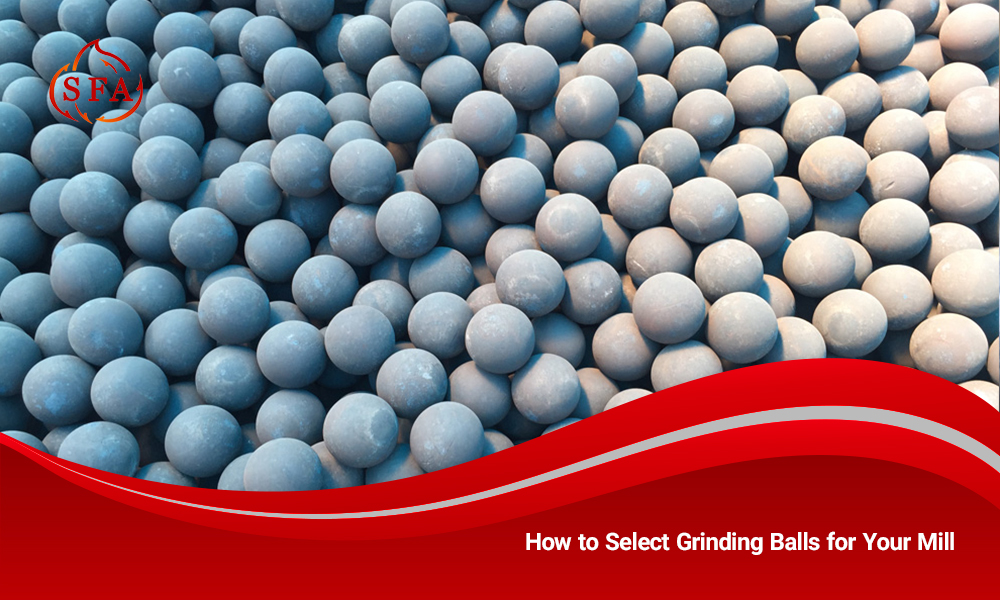

Choosing the Right Grinding Balls for High-Temperature Mills
High-temperature mills are the backbone of cement, mining, and advanced ceramic industries and operate in severe conditions where the temperature is as high as 500°C. Choosing the right grinding balls for high temperature mills is not a technical decision; it’s a strategic action that affects efficiency, cost, and product quality. At SFA, we have spent decades helping Middle Eastern customers optimize their milling operations. From a Qatar mill to a Dubai ceramics plant, our specialists have seen with their own eyes how the right grinding media can transform an operation. In this guide, we will explore choosing grinding balls for high-temperature milling, drawing upon information from trusted sources. Follow us on this article from the Sepahan Foolad Atashgah website.
Understanding of Grinding Balls and High-Temperature Problems
Grinding balls are the workhorses of ball mills, grinding material into powdery dust for uses in mining, cement, and pharma industries. In high-temperature mills, where operating temperatures as much as 500°C can exist, such grinding balls undergo severe thermal stress, abrasion, and potential chemical reaction. Choosing the right grinding balls for high-temperature mills is not simply choosing the hardest material but balancing thermal shock resistance, wear resistance, and mill liner and material compatibility.
Why is this significant? Take an example of a cement plant we have worked with in Qatar. They were using regular steel balls in a high-temperature mill and were having repeated liner replacements due to incompatible media. When they switched over from the grinding balls to high-chrome grinding balls, they saved 15% on maintenance. Such a practical difference shows how material selection matters. Let us therefore walk through the most critical considerations in choosing grinding balls for high-temperature mills.
Critical Considerations When Selecting Grinding Media for High-Temperature Mills
Critical considerations for the proper selection of grinding balls for high-temperature mills are:
1. Material Composition: The Foundation of Performance
The material composition of your grinding balls is the foundation upon which performance is measured, including their resistance to high temperatures, wear resistance, and failure to contaminate your product. Precise Ceramic describes the primary materials for high-temperature grinding media as:
- Ceramic Grinding Balls (Zirconia, Silicon Nitride): Ideal for uses where contamination-free grinding is imperative, like pharmacy or technical ceramics. Zirconia grinding media for high-temperature applications, says Kintek Solution, possesses extreme heat shock resistance and minimal wear rates. However, they cost more
- Steel Grinding Balls (Forged and High-Chrome): Steel balls, particularly high-chrome grinding balls for heat resistance, are the industrial champions in applications like mining and cement. Molycop demonstrates that high-chrome balls with chromium content of up to 30% possess advantage under abrasive, high-heat conditions due to hardness (up to 65 HRC) and corrosion resistance. Forged vs. cast grinding balls for mills is a hot debate—by Stanford Advanced Materials, forged balls tend to outperform cast ones in high-impact, high-heat conditions due to their tighter microstructure.
- Tungsten Carbide: In extreme conditions, tungsten carbide balls have unmatched hardness and thermal resistance, says Kintek Solution. It is pricier but worth every penny for specialized use like aerospace material milling.
If contamination is a concern (e.g., pharma), silicon nitride or zirconia would be the choice. Cement or mining with impact milling, high-chrome steel balls are typically the solution. Not sure what material would be ideal for your mill? Our engineers can assess your process—get in touch with your mill details for a quick recommendation.


2. Thermal Shock Resistance: Withstanding Temperature Fluctuations
High-temperature mills experience cycles of rapid cooling and heating, which lead to cracking or deterioration of grinding balls. Thermal shock resistant grinding balls are a necessity in such cases. RETSCH mentions that ceramic materials like silicon nitride are effective here because they maintain their structure even with sudden changes in temperature. For example, their CryoMill, typically used with silicon nitride balls, handles high-temperature milling with virtually no media degradation.
Prioritize resistance to thermal shock if your mill has an unstable temperature. Check your operating conditions and consult sources like FSA for material-specific data.
3. Hardness and Wear Resistance
Industrial milling wear resistant grinding balls are extremely important in cost savings on replacements and in ensuring efficiency. Manufacturers note that hardness (measured in HRC) instantly affects wear rates. High-chrome grinding balls with hardness ranging from 60-65 HRC are ideally suited for abrasive materials like clinker or ores. Ceramic balls, on the other hand, being less hard (approximately 1200 HV for zirconia), offer lower wear in non-abrasive high-temperature applications.
Always test prove your grinding media under high-temperature conditions in operational mill conditions. Small-scale test work can avoid thousands of dollars in long-term costs for choosing grinding balls for high-temperature milling.
Click to read the article «Casting Solutions for the Copper and Iron Ore Mining Sectors».
4. Mill Liner Compatibility
Your grinding balls must be compatible with your mill liners. Incompatible media may accelerate liner wear, increasing maintenance costs. Stanford Advanced Materials reminds that ceramic balls are compatible with ceramic or rubber liners and steel balls perform best in steel or alloy liners. One customer in Kuwait learned the hard way—operating steel balls on ceramic liners led to liner cracking within months. After they switched to zirconia balls, liner life doubled.
Plan your mill’s liner material and operating temperature. Sources like SFA provide comprehensive compatibility charts.
5. Cost vs. Performance Trade-Off
High-temperature grinding balls choice often boils down to cost versus functionality. Zirconia high-temperature grinding media may be up to 10 times more expensive than steel balls, but their longevity and contamination-free nature make the expense worthwhile in delicate applications. High-chrome steel balls offer an affordable solution for high-volume industrial grinding, such as in mining ball mills.
For example, an Australian mining client we advised reduced their grinding media expenses by 12% annually by optimizing their mix of forged and high-chrome balls. Is contamination-free grinding the first priority at your plant? Then steel balls could give you the biggest bang for your dollar. We can do the math for you. Just provide us with your budget and mill parameters.
Comparing Grinding Media Types for High-Temperature Mills
To get a clearer picture of the alternatives in choosing grinding balls for high-temperature milling, here is a quick comparison from Precise Ceramic, RETSCH, and Molycop perspectives:
- Zirconia Grinding Media: Suitable for high-purity, contamination-sensitive milling (e.g., ceramics, pharma). Extremely high thermal shock resistance, moderate hardness (1200 HV). Cost: High.
- Silicon Nitride: Suitable for extreme thermal cycling and high-energy mills (e.g., planetary ball mills). High thermal stability, low wear. Cost: Very high.
- High-Chrome Steel Balls: Optimal for abrasive, high-heat milling (such as cement, mining). Extremely hard (60-65 HRC), excellent corrosion resistance. Cost: Moderate.
- Forged Steel Balls: Long life for high-impact milling, slightly less heat-resistant than high-chrome. Cost: Low to moderate.
- Tungsten Carbide: Best suited for hardest materials and most demanding applications. Highest hardness (up to 1500 HV), though expensive and specialized.
Match the media to your mill material and operating conditions. Cement, for instance, can rely on high-chrome steel balls. For pharma, zirconia or silicon nitride is a cost worthwhile. Always ensure compatibility with your mill liners and material when choosing grinding balls for high-temperature milling.
Let us return to the world we live in. A Saudi Arabian cement plant we consulted was paying stratospheric maintenance costs due to ill-chosen grinding media. Their 550°C mill was consuming plain steel balls. Having surveyed their operation, we recommended high-chrome grinding balls for thermal endurance. The result? 22% reduction in ball wear and 10% boost in milling efficiency.
In one laboratory application, a UAE ceramics manufacturer was experiencing contamination issues in their high-temperature planetary ball mill. We suggested silicon nitride balls. The switch eliminated contamination issues, guaranteeing their high-purity product met stringent requirements. The proper grinding media for ball mills can transform your business.


How to Select Grinding Balls for Your Mill
So, how do you choose the right grinding balls for your high-temperature mill? Here’s a step-by-step process for choosing grinding balls for high-temperature milling:
1. Assess Operating Conditions: Note your mill’s temperature, material hardness, and cycling habits.
2. Assess Material Requirements: if you need contamination-free grinding, Ceramic balls are the way to go. If longevity is the point in choosing grinding balls for high-temperature milling, then High-chrome steel is what you need.
3. Assess Liner Compatibility: Ensure your balls won’t destroy your mill’s liners.
4. Test Trials: Test small grinding media batches to see how they perform compared to each other.
5. Consult Experts: Resources like Kintek Solution and Stanford Advanced Materials offer detailed guides, but our team can provide tailored advice. Share your mill details for a free consultation.
Conclusion
Choosing grinding balls for high-temperature milling is a trade-off of material characteristics, expense, and requirement needs. Whether in mining, cement, or advanced ceramics, the proper grinding balls can cut costs, improve efficiency, and prolong equipment life. Our experts know firsthand—customers throughout the Middle East have revolutionized their operations through sound decision-making. If you don’t know where to start, Check our website or ring us for a personal recommendation. Contact our colleagues and Commercial Manager for more advice and information.


